It’s quite common for tech companies to have standardized onboarding processes for developers or project managers, but what about onboarding technical writers?
Since a significant portion of a tech writer’s job consists of figuring out how products work, unfortunately they’re sometimes also left to their own devices after joining a new company and expected to decipher what their role exactly is.
Fortunately, there are actions you can take to provide your new writer with a better experience.
In this article, we’ll tell you about the crucial onboarding steps and resources you’ll need for onboarding the writer successfully and showing them you’ll continue supporting their growth.
Make Them Feel Welcome
To kick off the onboarding process in a positive tone, your priority should be making the new tech writer feel welcome and included.
If you ask tech writers what they dislike about their jobs, some of them will complain about feeling invisible compared to other roles in the company.
At least that’s the case in this Reddit thread about the pros and cons of choosing technical writing as a career.
Here’s one writer’s answer that reflects the common attitude:
“In the tech industry, most companies and some software engineers don’t respect or value what we do.”
So, when the new writer comes on board, you should work on making them feel valued from the get-go—you shouldn’t even give them the chance to feel underappreciated.
Karen Sawrey, an experienced tech writer in the software industry, gave a talk with tips for onboarding technical writers based on her own experience.
In it, she stated that an excellent onboarding experience always includes the employer’s effort to make the new hire feel appreciated.
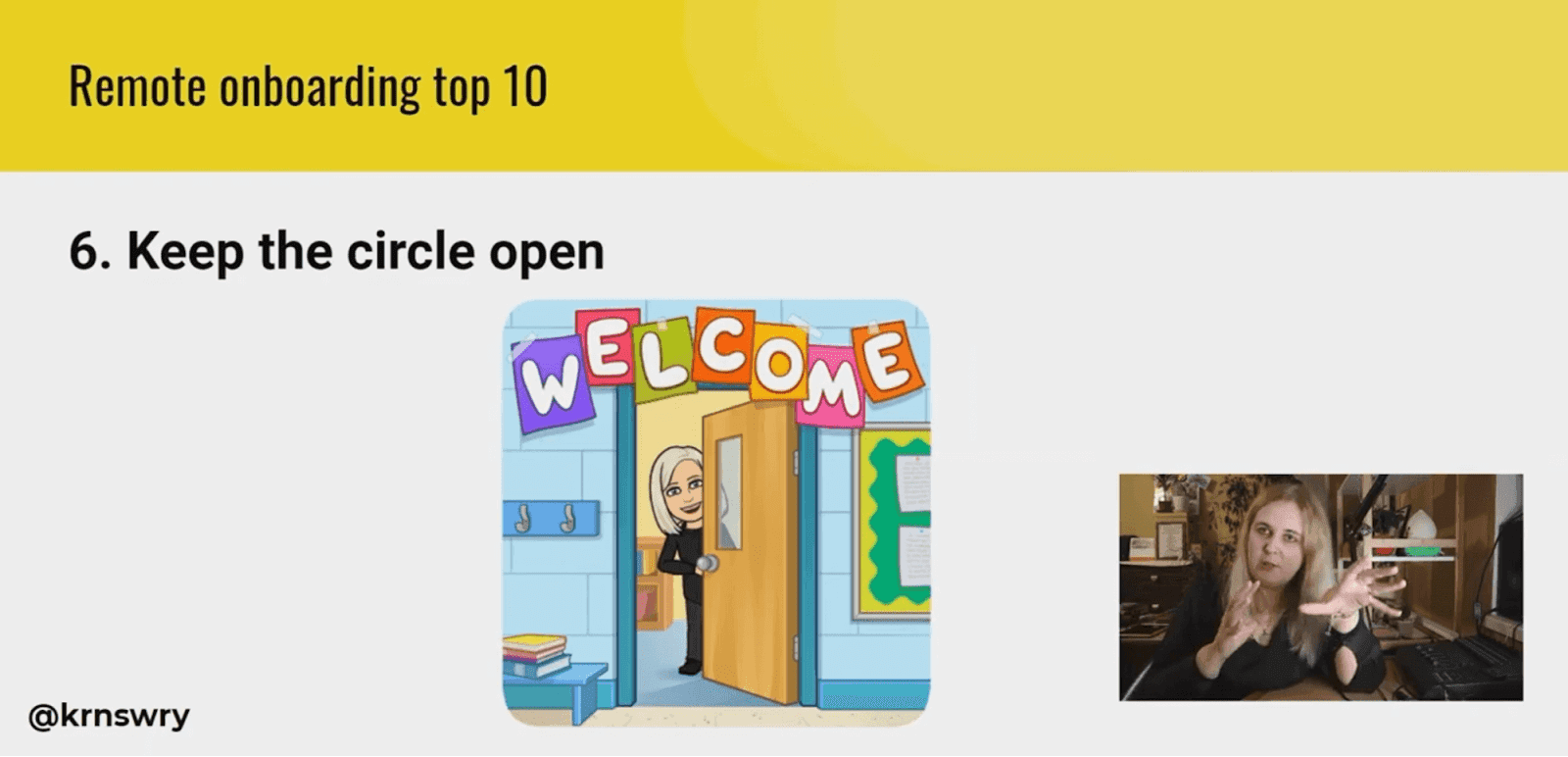
Source: Write the Docs on YouTube
You can achieve that by inviting the new hire to shared work and non-work spaces, or as Sawrey calls it, by “keeping the circle open”.
This technique also works in remote companies. While you probably can’t invite the new writer for drinks, you can ask them to share pet photos on Slack.
So, considering how overwhelming the onboarding can get, it’s better to give the writer an opportunity to familiarize themselves with other team members and the workplace instead of focusing solely on NDAs and tax forms during their first week.
And if you want to go the extra mile, you could also announce the new addition to the team on social media.
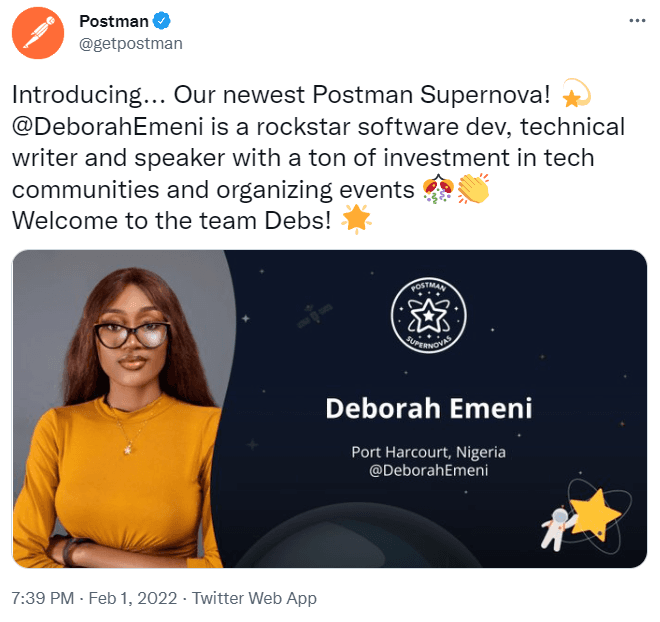
Source: Twitter
A social media post will show the writer you’re proud to have them and that tech writers are respected at your company.
With these uncomplicated steps, your new writer will see that their role matters, keeping them motivated for the rest of the onboarding process.
Provide Role Education
The responsibilities of a tech writer vary across companies, which is why the onboarding should include clearly defining the writer’s role.
While the new hire probably has a general understanding of what their job will entail, they shouldn’t base their expectations only on the responsibilities listed in the description of the job they applied for.
For instance, this job ad mentions that the writer will produce proposals, reports, and papers, but it doesn’t specify more details about how the work will get done.
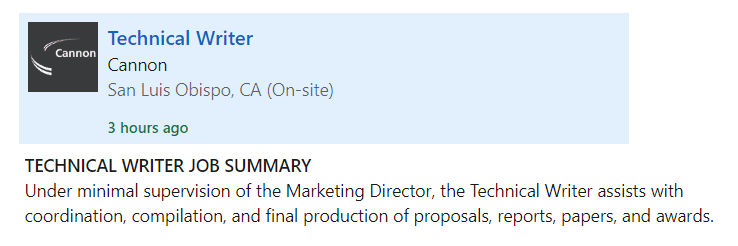
Source: LinkedIn
Of course, you can’t disclose all your internal processes in advance, but once the new writer joins the company, they should get an unambiguous picture of their job.
Unfortunately, according to Nicola Yap, one of Google’s lead technical writers, that’s not always the case.
Yap identifies the uncertainty about the role as one of the main flaws of tech writer onboarding processes she’s seen.

Source: Write the Docs on YouTube
She warns that when writers don’t know the full scope of their responsibilities, they unwittingly risk pigeonholing themselves into the role of a copyeditor for everybody else.
And since you’ve put so much effort into interviewing and selecting the best candidates, you wouldn’t want their potential to remain idle.
To make the onboarding more informative, Yap suggests dividing the education about the position into three categories: the scope of the role, writers’ relationships, and future career options.
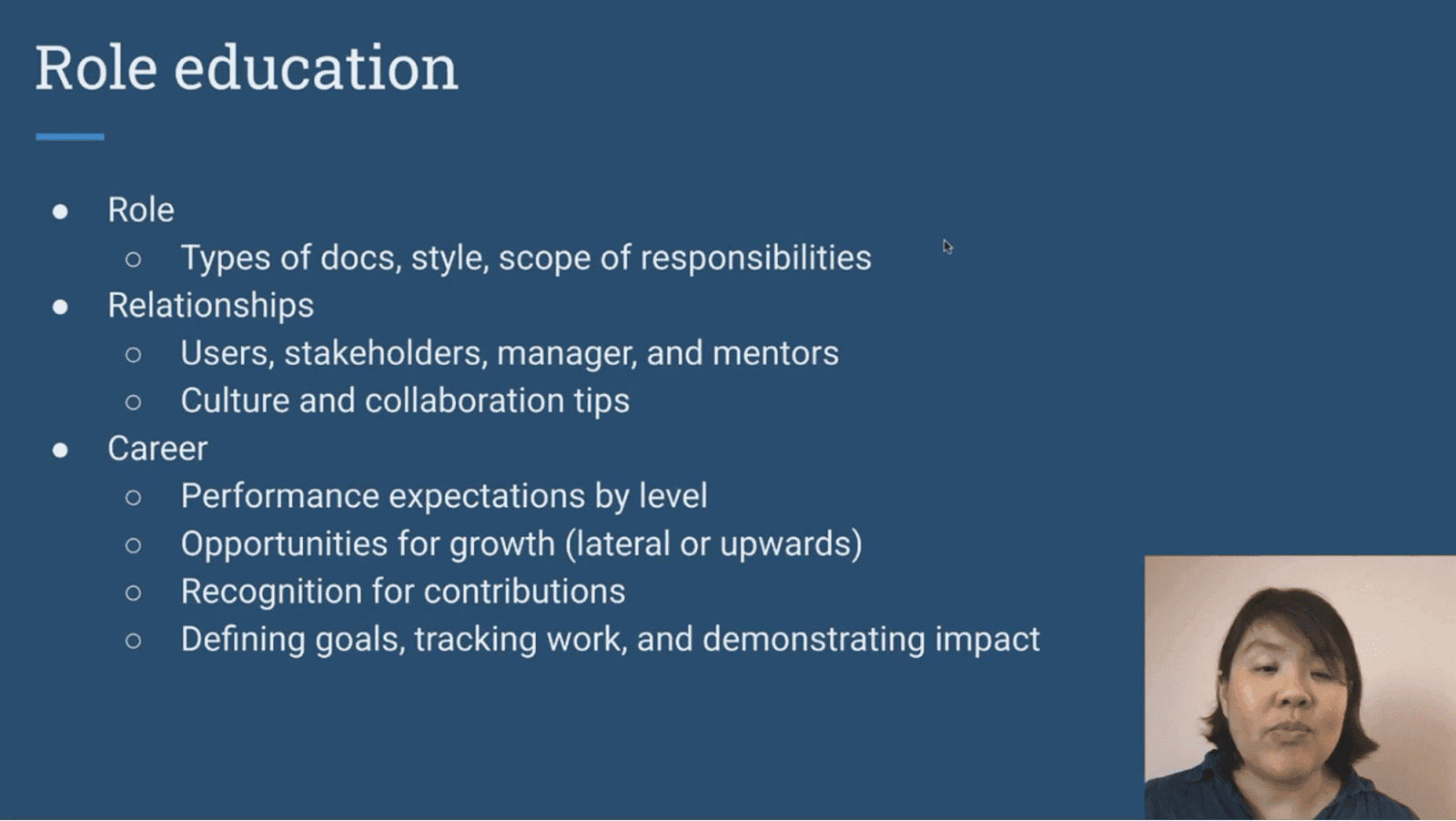
Source: Write the Docs on YouTube
So, you should use onboarding to clarify the exact type of documents the writer will write and walk them through the writing processes.
They also need to know who they’ll write for and who they’ll be collaborating with every day.
Lastly, you’ll provide a holistic representation of the role by describing the performance expectations and how the writer can advance their career at your company.
Equipped with that knowledge, your new writer will have a clear grasp of their responsibilities and the writing endeavors that await them.
Create Educational Materials
Educational materials are a crucial element of every onboarding process, regardless of the role.
To set your new technical writer up for success, you should prepare in advance all the resources and the tools they’ll need to work efficiently.
You can start by retracing an average workday of a writer in your company. Seeing their exact activities will help you compile the materials they need for all aspects of work.
For instance, Google’s writer onboarding toolkit covers the tools the writer needs for authoring, publishing, and managing documents.
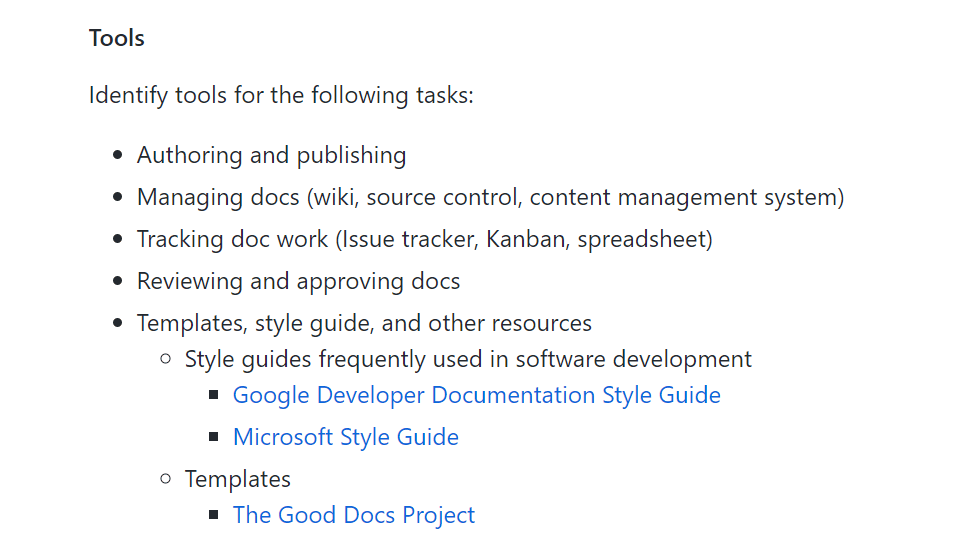
Source: GitHub
However, the toolkit also includes the materials related to the writing process, such as recommended style guides and templates.
These materials are especially useful because they ensure the uniformity of writing.
Rather than letting the new writer figure out your company’s tone on their own, you can equip them with a style guide where they can find clear, applicable directions.
The same goes for templates: the new writer should get access to all the materials that can streamline document creation.
For example, this tech specifications template available in our documentation platform Archbee could save writers plenty of time because it outlines the structure of the document.
That way, they could jump straight to writing and adjust the structure as needed.
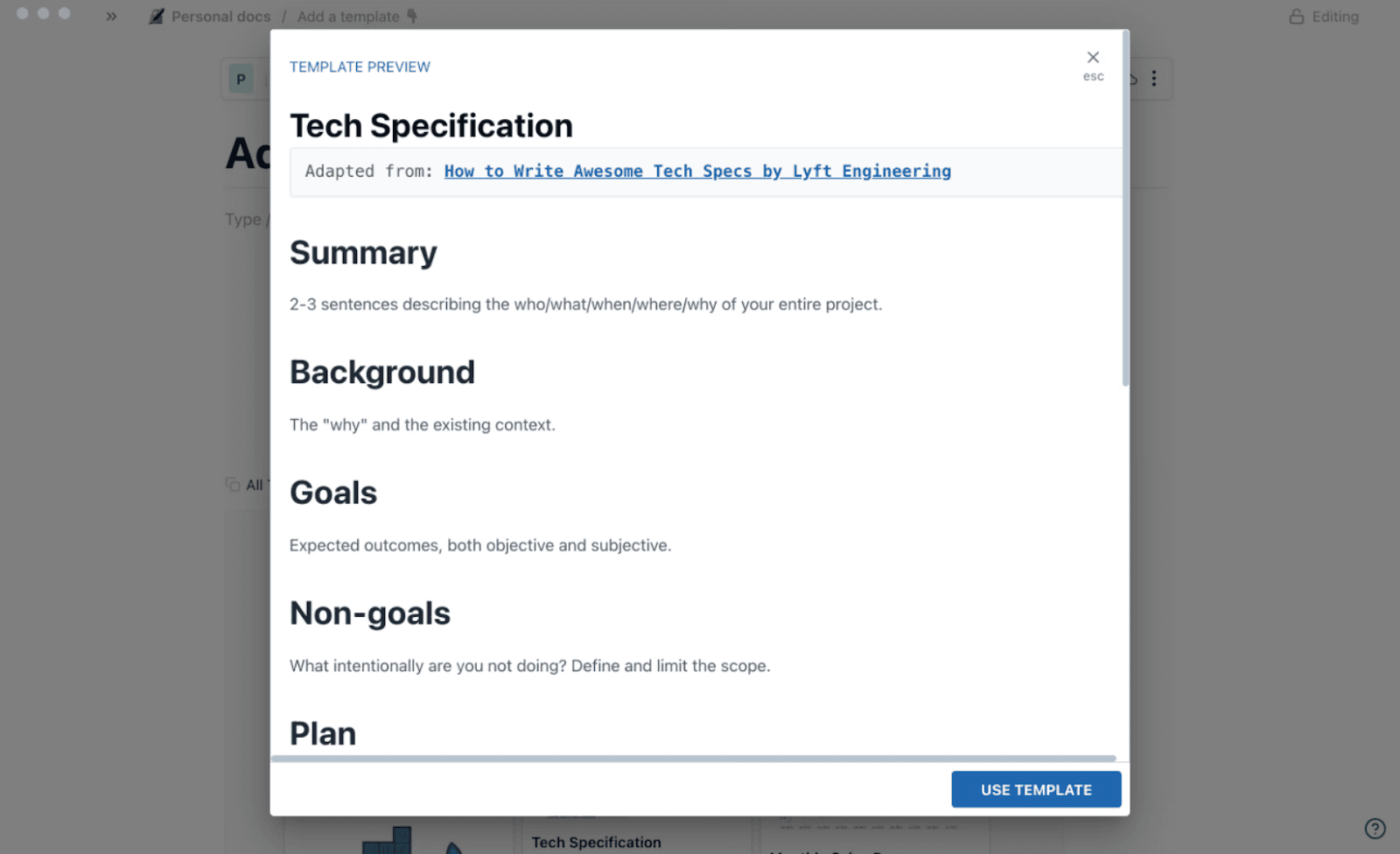
Source: Archbee
So, if your content team uses templates, make sure they’re available to the new tech writer as well.
An additional benefit of preparing educational and work materials is that they allow the new hire to self-onboard.
According to Michael Belton, lead technical writer at Carted, tech writers tend to become more comfortable with their new jobs when they actively participate in onboarding.
For that reason, he urges writers to ask their new company about the writing process implemented there.
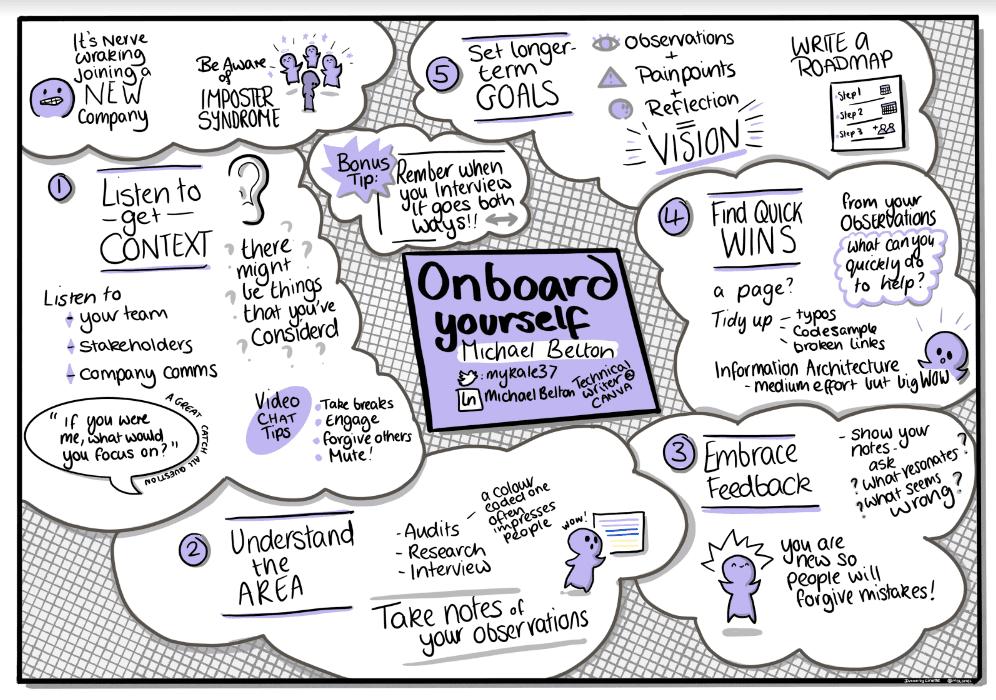
Source: Twitter
With that in mind, it’s wise to anticipate the writer’s questions and create materials that they can use to learn about the role.
You don’t have to limit the materials to the writing process; it’s helpful to also include the information about the products, users, and stakeholders that they’ll work with.
By creating comprehensive materials, you’ll help the writer successfully navigate the new workspace and enable them to become an independent contributor quickly, so don’t skip this onboarding step.
Offer a Safe Space for Questions
No matter how thorough your onboarding process is, there’s still a chance that the new writer will have additional questions.
If you want to help them prepare for the role, you should create a space where they can feel comfortable asking for more information and guidance.
Let’s return to Michael Belton’s advice for onboarding tech writers.
In the presentation he gave about the topic, Belton compiled a list of questions that writers can ask the team and the stakeholders, such as “How is the content organized?” and “What are the next projects?”
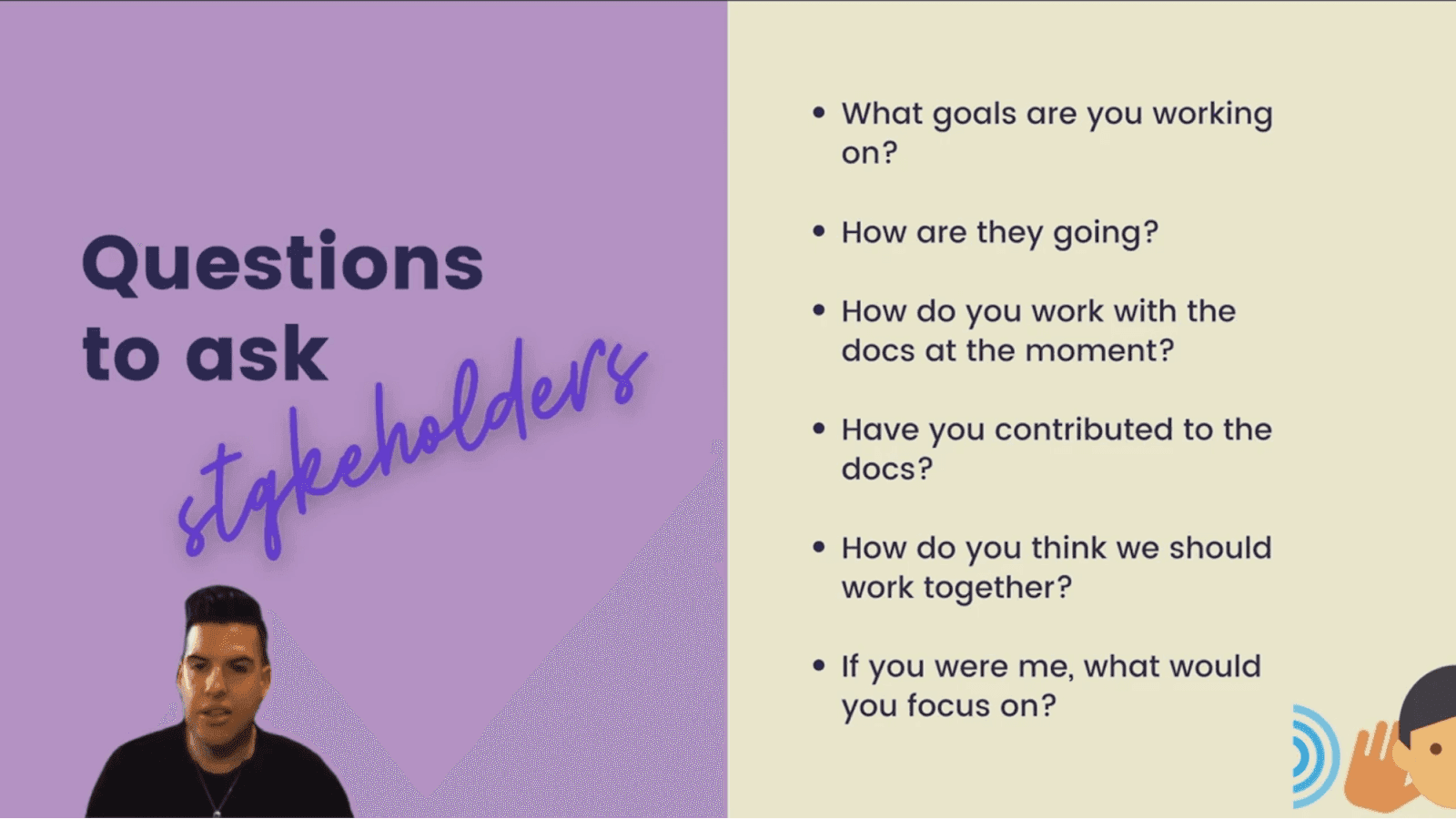
Source: Write the Docs on YouTube
Bear in mind that even such straightforward questions take some courage to ask, especially when a writer is in a new environment.
And when it comes to more complex questions, such as those about needing help or not being sure about the task at hand, new writers might keep the questions to themselves in order not to seem uninformed.
You can prevent that by emphasizing that you are happy to elaborate on whatever needs clarification, especially during the onboarding and early phases of work.
An onboarding buddy or a trainer may also be helpful here.
If your new writer has a designated person they can direct their questions to, they’ll be more likely to ask for help when they need it.
That’s why some businesses, like GitLab, pair new writers with trainers, groups, or coaches to work with at the beginning of their careers at the company.

Source: GitLab
GitLab’s tech writer onboarding system allows the new hires to ease into work and provides them with a network of people they can ask for guidance.
In other words, new hires have a place to reach out with questions when they feel uncertain about work or need clarification about a process or a task.
So, if you don’t want the new writer to struggle with unresolved issues, it’s your responsibility to offer a safe space of questions.
Whether you formally assign them a trainer or encourage them to speak to all team members, your writer will appreciate knowing that they have somebody to turn to for help.
Introduce a Friction Log
If you want to know how successfully you’ve equipped your new writer for work, you’ll need to hear directly from them.
The friction log, a tool borrowed from product management, can help you with that.
Let’s start by defining a friction log, and then we’ll see how the tool fits into the tech writer onboarding process.
Frictions logs are documents that you write while doing a task to capture your emotions along the way.
They are mostly used in product testing for assessing how a customer might feel using the product.
The crucial element of friction logs are the logging keys you use to describe your attitudes that arise while solving a problem.
For instance, this friction log template designed by Chameleon suggests using green for pleasant experiences and red for frustrating ones.
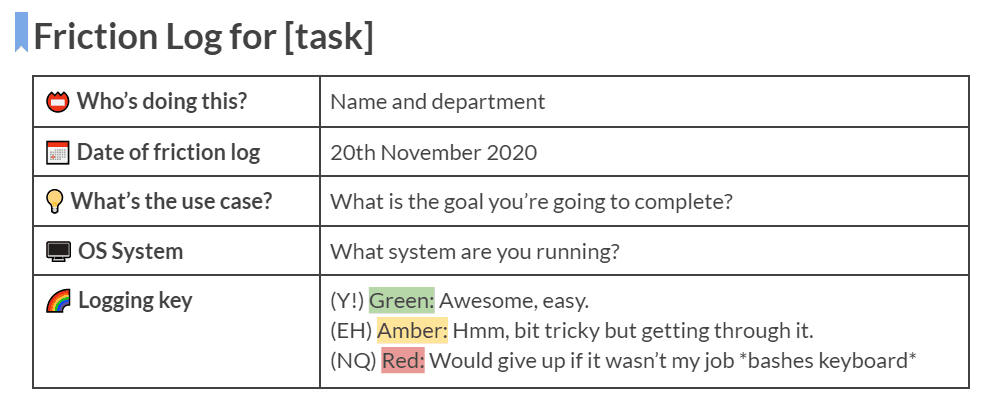
Source: Chameleon
At this point, you might be wondering how any of this fits into the context of onboarding technical writers.
Essentially, you can ask your newly-joined writer to file a friction log once they start working on their first practice assignment.
The result could look something like this:
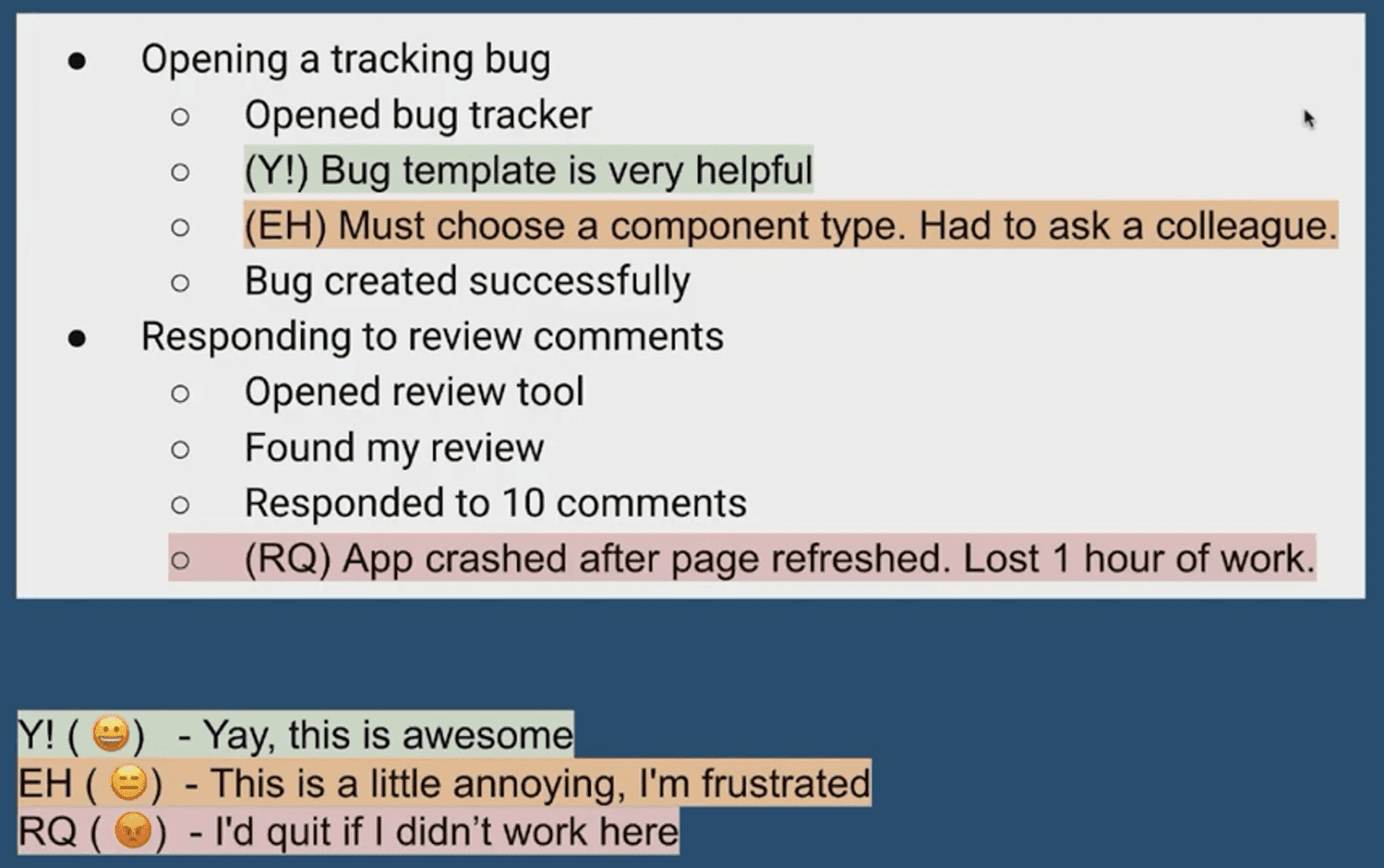
Source: Write the Docs on YouTube
The image above shows an example of a friction log created by Google’s tech writer Nicola Yap.
Yap claims that friction logs are an excellent way for a new tech writer to communicate their opinions about the writing processes implemented at the company.
That way, you’re creating an opportunity for discussion.
The new writer can leave feedback about the areas for which the onboarding process could have prepared them better, and senior writers can provide assistance and mentorship.
Together, both the person writing the friction log and the person reviewing it can come up with suggestions for improvement, so that the next writer who joins has a better onboarding and, ultimately, writing experience.
Recognize Their Efforts
Lastly, we suggest that you round the onboarding process off by acknowledging the value the new technical writer brings to your team and by making the importance of the role known company-wide.
Although there are some instances where tech writers are called the “unsung heroes” of software and product development, a more common scenario is that they don’t feel valued enough on a daily basis.
For instance, this tech writer took to Reddit to complain about their fellow colleagues not even understanding what writers do.

Source: Reddit
If you don’t want your writers to face similar problems, you should use the onboarding as an opportunity to recognize the importance of their role.
You can foster a supportive environment by encouraging all team members to participate in documentation as soon as the writer joins the team.
That can mean asking the technical SMEs to set aside the time for the writer’s interview or encouraging developers to review the documents.
Either way, you’ll connect the writer to the team and show them that their contributions are far from invisible.
Of course, the tech writer will still be the primary creator of documents.
Still, taking a collaborative approach to documentation will draw the attention of the entire team to the results the writer is generating.
And doing so during onboarding will set a positive tone for the rest of the writer’s career with your team.
Conclusion
As you can see, onboarding technical writers entails more than showing them the workstation and sending the link to the style guide your documents follow.
Instead, you have to actively guide them through the onboarding process, helping them learn not only about the writing practices, but also about the way tech writers enrich your company as a whole.
With such a thorough approach to the onboarding process, you’ll help the new technical writer settle in and confidently dive into document creation.
Frequently Asked Questions
New technical writers often run into unclear role expectations, needing to figure out how complex products work, and feeling overlooked compared with engineering or product roles. Without explicit guidance, they can be pigeonholed as copyeditors, struggle to identify their audience and key collaborators, and lack visibility into processes, tools, and success metrics—all of which slows their impact.



